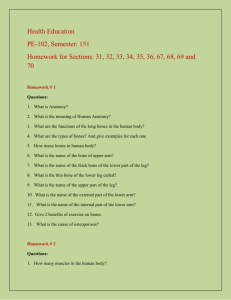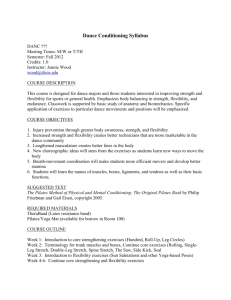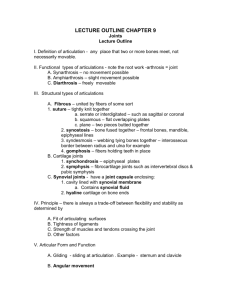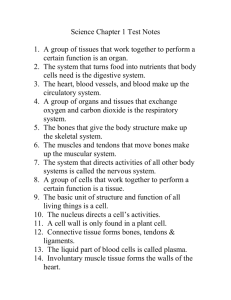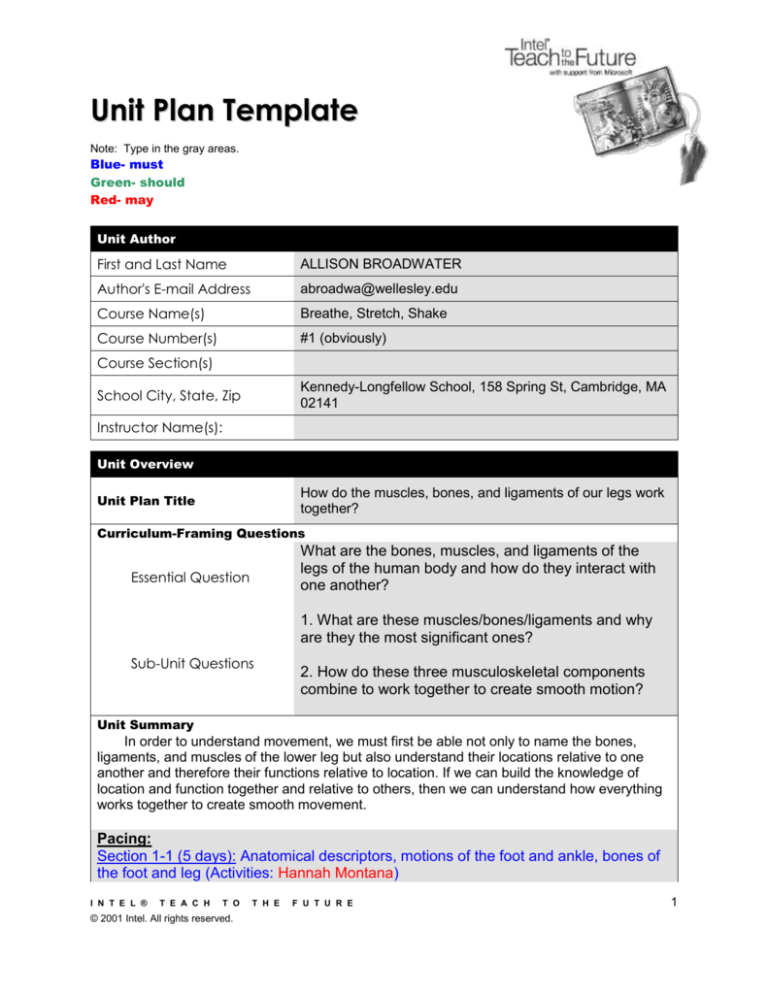
Unit Plan Template
Note: Type in the gray areas.
Blue- must
Green- should
Red- may
Unit Author
First and Last Name
ALLISON BROADWATER
Author's E-mail Address
abroadwa@wellesley.edu
Course Name(s)
Breathe, Stretch, Shake
Course Number(s)
#1 (obviously)
Course Section(s)
Kennedy-Longfellow School, 158 Spring St, Cambridge, MA
02141
School City, State, Zip
Instructor Name(s):
Unit Overview
How do the muscles, bones, and ligaments of our legs work
together?
Unit Plan Title
Curriculum-Framing Questions
What are the bones, muscles, and ligaments of the
legs of the human body and how do they interact with
one another?
Essential Question
1. What are these muscles/bones/ligaments and why
are they the most significant ones?
Sub-Unit Questions
2. How do these three musculoskeletal components
combine to work together to create smooth motion?
Unit Summary
In order to understand movement, we must first be able not only to name the bones,
ligaments, and muscles of the lower leg but also understand their locations relative to one
another and therefore their functions relative to location. If we can build the knowledge of
location and function together and relative to others, then we can understand how everything
works together to create smooth movement.
Pacing:
Section 1-1 (5 days): Anatomical descriptors, motions of the foot and ankle, bones of
the foot and leg (Activities: Hannah Montana)
I N T E L ®
T E A C H
T O
© 2001 Intel. All rights reserved.
T H E
F U T U R E
1
Section 1-2 (~2 days): Ligaments of the ankle (Activities: group work on chart paper to
determine major ligaments with clues)
Section 1-3 (~2 days): Muscles of the lower leg (3 compartments) (Activities: model of
the ankle joint to demonstrate muscle differentiation)
Section 1-4 (1 day): Ligaments of the knee
Section 1-5 (1 day): Major upper leg muscles (Activities: model of the knee joint
including the patella)
Subject Area(s): (List all subjects that apply)
Anatomical Descriptors
Bones (foot and leg)
Ligaments (ankle and knee)
Muscles (Lower leg compartments; upper leg quads and hamstrings)
Grade Level (Click boxes of all grade levels that apply)
K-2
6-8
ESL
Gifted and Talented
3-5
9-12
Resource
Other:
Student Objectives/Learning Outcomes [taken from CPS Outcomes]
CONTENT
Introduction to Anatomical Study
SWBAT identify and determine the difference between pairs of complementary
anatomical descriptors and be able to use them to describe anatomical locations.
SWBAT define and differentiate the difference between a muscle, ligament, and
tendon.
SWBAT define articulation of bones in a joint
Bones
SWBAT identify and locate the groups of bones of the foot
SWBAT use anatomical descriptors to locate the bones of the foot relative to one
another
SWBAT identify the bones of the leg and their relative positions
SWBAT identify the bony components of the ankle joint
Ligaments
SWBAT use knowledge of the bones and their anatomical positions to define the
major ligaments of the ankle
SWBAT identify the major ligaments of the knee
SWBAT begin to apply knowledge of bony position and movement to identify possible
common injuries to major ligaments
Muscles
SWBAT identify the locations of the three major compartments of muscles in the lower
leg
SWBAT apply knowledge of anatomical location and muscle contraction to identify the
primary functions of each of the lower leg compartments
I N T E L ®
T E A C H
T O
© 2001 Intel. All rights reserved.
T H E
F U T U R E
2
SWBAT identify the primary functions of the two primary groups of muscles in the
upper leg and the knee joint
INQUIRY
Students will build on knowledge from each portion to apply to the others; anatomical
descriptors to understanding bones of the foot; bones of the foot and leg and
anatomical descriptors to identifying ligaments and muscles, etc
Students will use model making to demonstrate the movements of the ankle joint as a
result of particular muscle compartments
Students should be able to use memorizing tools, from mnemonics to songs, to help
memorize the bones in particular
Materials and Resources Required For Unit
Technology – Hardware (Click boxes of all equipment needed.)
Camera
Laser Disk
Computer(s)
Printer
Digital Camera
Projection System
DVD Player
Scanner
Internet Connection
Television
VCR
Video Camera
Video Conferencing Equip.
Other: SMARTBoard
Technology – Software (Click boxes of all software needed.)
Database/Spreadsheet
Image Processing
Desktop Publishing
Internet Web Browser
E-mail Software
Multimedia
Encyclopedia on CD-ROM
Web Page Development
Word Processing
Other: Turning Point
Anatomy books- lots.
Printed Materials
Coloring sheets
Supplies
Internet Resources
Toilet paper rolls, markers, rubber bands, tape
Lots and lots of paperclips
Models of the foot, leg, and knee
YouTube!
StudyStack.com
Others
Accommodations for Differentiated Instruction
I N T E L ®
T E A C H
T O
© 2001 Intel. All rights reserved.
T H E
F U T U R E
3
English language learners (ELL)
New vocabulary introduced off familiar portions/roots;
also limited to only what is necessary to build on other
new vocabulary
Cornell note-taking organizer use encouraged
All
Resource Student
X
X
Gifted Student
Introduction of all vocabulary in class rather than outside
Partner activities in critically putting information together
to encourage group work and building knowledge off one
another
Memorization tools used in class and encouraged for
homework to make new vocabulary accessible to all
different students
Model building allows for visual representation
Open-ended independent work (drawing, model building)
allows for creativity
Partner/class work independent of the teacher allows for
different knowledge levels to build on one another
Student Assessment
Students will be assessed on their performances on:
Class review sessions
Homework (flashcards, coloring, drawing)
Model building
Partner chart building to define muscle and ligament functions
Community Meeting performance
Using vocabulary in the correct context when appropriate, whether or (preferably) not
encouraged
Page 4 of 4

